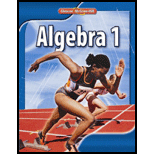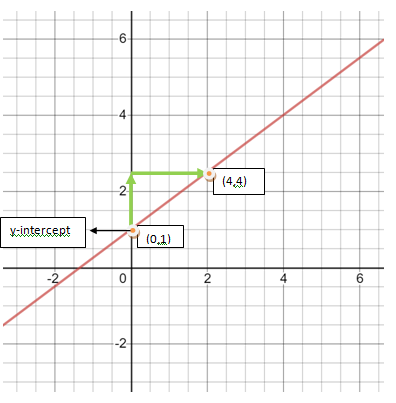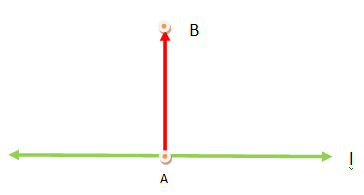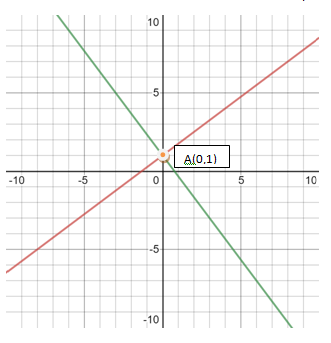
Concept explainers
(a)
To Graph :
(a)
Explanation of Solution
Given Information:
Equation of line is
Concept Used:
The slope-intercept form of a line is :
Graph:
This equation is in slope-intercept form.
Here ,
The y-intercept is the point (0,1).
Now
Steps to draw the line :
1.Start at the origin and move 1 unit up. Draw a point at (0,1) = (0,c)
2.The slope is
You are now at (4,4) = (b,c+a). Draw a point here.
3. Continue this process. Now use a ruler and connect the points and extend the line in both directions.

(b)
To Draw:
Use protrector to draw a line perpendicular to the line drawn in (a)
(b)
Explanation of Solution
Concept Used:
Construction of perpendicular lines with the help of protractor:
a. Let l be the given line and A the given point on it.

b. Place the protractor on the line l such that its base line coincides with l, and its centre falls on A.
c. Mark a point B against the 90° mark on the protractor.
d. Remove the protractor and draw a line m passing through A and B.

Then line m is perpendicular to line l at A.
Graph:
Draw a line with the help of Protractor :
Keeping (0,1) as point A in the protractor and

(c)
To Find :
Equation of line drawn in part (b)
(c)
Explanation of Solution
Concept Used:
The slope-intercept form of a line is :
Calculation:
1.Find the slope
Choose (0,1) as the point through which line passes and find the y-intercept
Write the equation using Slope Intercept form
Hence, required equation of line is
(d)
To Compare :
The slopes of lines in part (a) and (c)
(d)
Explanation of Solution
Given Information :
Equations of lines from part (a) and (c) :
Interpretation:
From part (a) and (c)
We have slopes of lines
So, we have the relation between the slopes of perpendicular lines.
The product of slopes of two perpendicular lines is -1.
Chapter 4 Solutions
Algebra 1
Additional Math Textbook Solutions
Algebra and Trigonometry (6th Edition)
University Calculus: Early Transcendentals (4th Edition)
Basic Business Statistics, Student Value Edition
Elementary Statistics: Picturing the World (7th Edition)
- Solve the following system of equations: 50x+20y=1800 10x+3y=300arrow_forward> > > we are hiring Salesforce Admin Location: Remote Key Responsibilities: Administer Salesforce Sales & Revenue Cloud (CPQ & Billing) Configure workflows, validation rules & dashboards Automate processes using Flows & Process Builder Collaborate with Sales, Finance & Marketing teams Manage user roles & security Apply: Hr@forcecraver.comarrow_forwardAnswer this questionarrow_forward
- 1. vector projection. Assume, ER1001 and you know the following: ||||=4, 7=-0.5.7. For each of the following, explicitly compute the value. འབ (a) (b) (c) (d) answer. Explicitly compute ||y7||. Explain your answer. Explicitly compute the cosine similarity of and y. Explain your Explicitly compute (x, y). Explain your answer. Find the projection of onto y and the projection of onto .arrow_forward2. Answer the following questions using vectors u and v. --0-0-0 = find the the cosine similarity and the angle between u and v. འརྒྱ (a) (b) find the scalar projection of u onto v. (c) find the projection of u onto v. (d) (e) (f) find the scalar projection of onto u. find the projection of u onto u. find the projection of u onto and the projection of onto . (Hint: find the inner product and verify the orthogonality)arrow_forwardPlease type out answerarrow_forward
- The function f(x) = log x is transformed to produce g(x) = log (x) – 3. Identify the type of transformation and describe the change. Please type out answerarrow_forwardEach graph below is the graph of a system of three linear equations in three unknowns of the form Ax = b. Determine whether each system has a solution and, if it does, the number of free variables. A. O free variables ✓ B. no solution C. no solution D. no solution E. 1 free variable F. 1 free variablearrow_forwardSolve the following systems of equations and show all work.y = x2 + 3y = x + 5 Please type out answerarrow_forward
 Algebra and Trigonometry (6th Edition)AlgebraISBN:9780134463216Author:Robert F. BlitzerPublisher:PEARSON
Algebra and Trigonometry (6th Edition)AlgebraISBN:9780134463216Author:Robert F. BlitzerPublisher:PEARSON Contemporary Abstract AlgebraAlgebraISBN:9781305657960Author:Joseph GallianPublisher:Cengage Learning
Contemporary Abstract AlgebraAlgebraISBN:9781305657960Author:Joseph GallianPublisher:Cengage Learning Linear Algebra: A Modern IntroductionAlgebraISBN:9781285463247Author:David PoolePublisher:Cengage Learning
Linear Algebra: A Modern IntroductionAlgebraISBN:9781285463247Author:David PoolePublisher:Cengage Learning Algebra And Trigonometry (11th Edition)AlgebraISBN:9780135163078Author:Michael SullivanPublisher:PEARSON
Algebra And Trigonometry (11th Edition)AlgebraISBN:9780135163078Author:Michael SullivanPublisher:PEARSON Introduction to Linear Algebra, Fifth EditionAlgebraISBN:9780980232776Author:Gilbert StrangPublisher:Wellesley-Cambridge Press
Introduction to Linear Algebra, Fifth EditionAlgebraISBN:9780980232776Author:Gilbert StrangPublisher:Wellesley-Cambridge Press College Algebra (Collegiate Math)AlgebraISBN:9780077836344Author:Julie Miller, Donna GerkenPublisher:McGraw-Hill Education
College Algebra (Collegiate Math)AlgebraISBN:9780077836344Author:Julie Miller, Donna GerkenPublisher:McGraw-Hill Education





